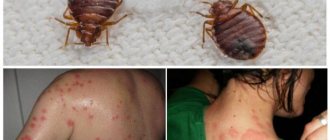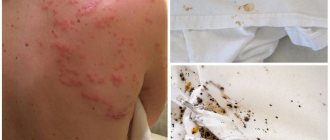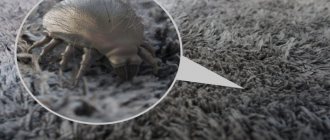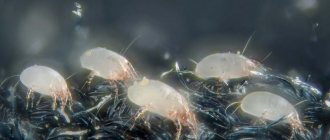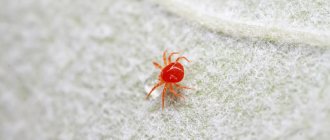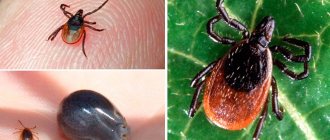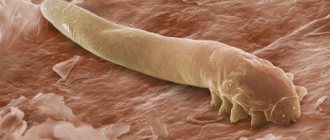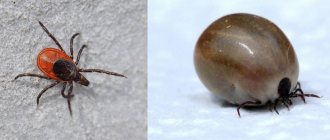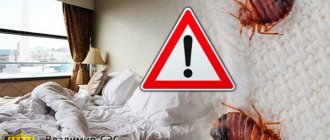Dust mites , or bed mites , are domestic parasites belonging to the arthropod family. Their habitat is dust, and their food source is dead human skin cells. Bed mites are unpretentious and can survive in almost any conditions. The most favorable environment for their living is warm and humid, the temperature is about 21 degrees Celsius, that is, the one that is installed in living quarters, and there is an abundance of food (epithelium). This explains their wide distribution.
Such parasites can cause allergies, and prolonged exposure to them can lead to the development of sinusitis and even asthma. In addition, the scabies mite provokes a disease such as scabies, which occurs with regular contact with its waste products.
That is why it is important to know what a tick that lives at home looks like and how to get rid of it.
You may be confusing dust mites with bed bugs or marks on your skin with bed bug bites.
Main types of house ticks
House ticks are a separate biological group of parasites that live in the residential environment. They not only spoil food, clothing and furniture, but also affect the health of humans and animals.
The following types of ticks can appear and reproduce in the living environment:
- Hairy house tick . This pest lives in flour, grain, plant and animal residues, and even in cheese and tobacco. Such mites actively develop at a temperature of 23-25 degrees and a relative air humidity of 80-90%. They can cause dermatitis in humans;
- Scabies mite (itching) . It develops and parasitizes only on humans in high humidity and warmth. It is the causative agent of scabies;
- Rat mite . The parasite primarily attacks rats, but, in the absence of a natural host, can attack other mammals, as well as humans. Rat mites cause a difficult to treat disease - rat mite dermatitis. This parasite is common in rural areas and poses a danger to its inhabitants;
- Chicken mite . This type of parasite is widespread throughout the world. Mainly lives in nests and droppings of birds, cracks of wooden surfaces. Can parasitize on the surface of human skin, causing skin rashes and irritations;
- Bird mite . This tick parasitizes wild and domestic birds, that is, it lives in close proximity to humans and is capable of attacking them.
Household ticks are dangerous not only because of their bites, but also because of the impact of their own feces on humans and pets.
Folk recipes
Some people are afraid to use chemicals. In this case, you can remove the ticks using improvised means. To do this, take 25 ml of liquid soap and dilute it in a liter of clean water. Half a glass of ammonia is also added there. The resulting mixture is thoroughly mixed. All rooms are treated with it and used for washing clothes.
Parasites do not like some plants, so dry bunches should be distributed in areas where ticks live. Tansy, wild rosemary, and wormwood are suitable. Vinegar, boric acid or turpentine are used as floor cleaners. They are bred in a bucket of water. To prepare a concentrated solution, 1 teaspoon is enough.
What a dust mite looks like - photo under a microscope
Dust mites are invisible to the naked eye because they are only 0.5 mm long. It is possible to study the details of the structure of his body only with the help of a microscope.
One gram of house dust can contain from hundreds to thousands of parasites. It is known that their numbers increase significantly from August to October, especially after the start of the heating season.
A tick of this species, like all arachnids, has a flattened body, consisting of individual segments connected to each other. The linen mite moves with eight legs. Each limb has suction cups, thanks to which the harmful microorganism is firmly attached to surfaces. With the help of two pairs of jaws, the parasite captures and grinds food, and also pierces the skin of the host, as some mistakenly believe.
The body of dust mites is covered with a kind of water-repellent layer. If you examine the parasite using a microscope, you can come to the conclusion that it looks like an ordinary small spider. About 150 species of mites are known to live in house dust.
Photo
Next you can see a photo of bites on a human body, as well as how the insect looks under a microscope.
Where do dust mites start and live?
Most often, dust mites are concentrated in dusty environments that are difficult to clean, as well as in bedding. They can be found:
- In a pillow filled with natural bird feathers;
- In the mattress, especially if it is old and has not been cleaned for a long time. It is claimed that such mattresses consist of 10% mites;
- In a blanket that is stuffed with cotton wool;
- In a carpet made from natural materials, the pile of which can also be eaten by parasites;
- In bed linen;
- In furniture upholstery;
- In curtains and drapes;
- On bookshelves that are rarely dusted;
- In a bag located in the vacuum cleaner;
- In soft toys made from natural materials;
- In stale old clothes;
- In woolen blankets.
According to the Federal Budgetary Institution “Center for Hygienic Education of the Population” of Rospotrebnadzor, one gram of dust contains from 10 to 10,000 dust mites. In addition to them, about 350 thousand colonies of bacteria and about 100 thousand clusters of fungi live on bed linen.
The waste products of sofa mites, which cause allergic reactions, enter the air, slowly settle on the surface and gradually accumulate. Allergens get not only onto furniture and things, but also onto human skin and even into the respiratory tract.
Step-by-step instructions on how to detect them
In the apartment
Finding dust mites in an apartment is problematic. Due to their microscopic size it is impossible to see them, but these creatures live in varying quantities wherever people live. If a person does not have any allergic reactions, most likely the concentration of mites in his apartment is low. The owner may not even know about the existence of these parasites in his home. If any unusual reactions of the body to inhaled dust appear, it can be assumed that uninvited guests live in the apartment.
If you suspect the existence of parasites in your apartment, you can purchase special test strips at the pharmacy that can easily detect dust mite allergens and determine their number. In addition, you can invite a special team involved in the fight against parasites. Specialists will take dust samples and, if parasites are found, will carry out a complete disinfection of the home.
On the skin
In humans, swelling and redness in the form of bumpy pimples can be found at the sites of bites, and unbearable itching appears in the affected area. People sensitive to allergies experience red eyes, headaches, and a feeling of exhaustion.
REFERENCE! Following the physical manifestations of bites on the skin, a person experiences nasal congestion, he begins to sneeze for no reason, a burning sensation appears in the nasal sinuses, and less often in the throat.
In addition to allergic reactions, dust mite bites can cause:
- asthma;
- inflammation of the mucous membrane and larynx;
- dermatitis;
- conjunctivitis.
How do bed ticks bite? Do they bite?
Many people are concerned about whether mattress mites bite and, accordingly, what the bite looks like. This type of parasite does not bite and does not spread infection. This is due to the fact that the pests are too small and cannot bite through human skin.
The cushion mite causes harm in a different way, through its metabolic products. These include:
- Cuticle remaining after molting;
- Secretions produced by parasites;
- Feces that contain proteins that cause allergic reactions.
Those who are predisposed to allergies should be especially careful, because the parasite causes extremely unpleasant symptoms that can develop into a serious illness. That is why, if alarming signs are detected, it is worth contacting an allergist or immunologist to check for suspected tick allergies.
The rash that appears on the skin in response to the activity of the mite is confused by some with bed bug bites. In fact, bed bugs, unlike ticks, leave very specific bites: they are numerous and grouped, looking like large swellings with a pronounced red seal in the middle.
Answers to popular questions
Dust mites are an invisible parasite that causes a lot of inconvenience for allergy sufferers. You need to know as much as possible about it in order to take timely measures.
How to detect a tick?
Parasites cannot be seen without a microscope, but an increase in their population will lead to a change in the human condition.
You can recognize the widespread presence of arachnids indoors by several symptoms:
- skin rashes;
- weakness and nervousness;
- fatigue, sleep disturbances;
- sneezing for no apparent reason;
- inflammation of the membranes of the eye;
- nasal congestion;
- dyspnea.
What do ticks look like?
These arthropods do not look very attractive. The largest part of the body is the torso. There are small pincers on it instead of a head. There are 6 paws that resemble claws in appearance.
What causes mites to appear in bed?
Why is the bed most often attacked by dust mites? How do they get here?
The fact is that in every home, despite diligently maintaining cleanliness, there is a small population of these parasites. With frequent cleaning, washing and cleanliness of linen, replacing the filling in feather pillows with a more modern one, the number of mites is kept within the acceptable range: they are not enough to become a source of allergies.
If wet cleaning of premises and changing of bed linen is carried out rarely, a large number of keratinized skin particles accumulate in the layer of dust and on the fabric of bedding, on which clothes mites feed. Thus, favorable conditions are created for their nutrition, development and reproduction.
You should be especially careful: bed mites are often observed in rented apartments and rooms in inexpensive hotels, where guests often change and bed linen is not properly processed.
Preventive measures
Of course, it is easier to prevent a problem than to fight it. To reduce the risk of a massive appearance of dust mites, clean your apartment regularly, wipe horizontal surfaces and floors with a damp cloth, wash bedding and accessories on time, clean carpets and upholstery.
Additional tips:
- Change pillows and blankets every 5 years. Give preference to synthetic rather than natural fillers.
- Buy a hypoallergenic mattress. Ventilate it regularly in the sun or frost, clean it with a steam generator, or take it to the dry cleaner once every 12 months.
- Don't sleep on a bed without bedding.
- Store books in locked cabinets.
- Ventilate your apartment daily.
- Use air purifiers.
- For cleaning, use washing vacuum cleaners or devices with hepa filters.
- Do not forget to regularly wash curtains, curtains, toys, covers on chairs and sofas.
- From time to time, inspect your apartment and throw away unnecessary trash.
- Groom your pets regularly, bathe and brush their hair.
Following these rules will help prevent the appearance of dust mites and reduce the risk of allergic reactions.
Dust mites are a dangerous pest. It does not parasitize human skin, but it secretes dangerous enzymes that contribute to allergic reactions in adults and children. The main enemy of the parasite is cleanliness. With regular wet cleaning, you will not only get rid of the problem, but also prevent its occurrence, thereby reducing the risk of life-threatening allergic reactions.
Remedies and methods for getting rid of bed mites
None of the existing methods guarantees the complete elimination of the feather mite population, but by taking the necessary measures, it is quite possible to reduce its population to a safe level. Under such conditions, you can be sure that parasites will not cause allergies.
How to get rid of bed dust mites? There are several types of means with which you can control their vital activity.
Chemicals, preparations and suspensions, the composition of which makes it possible to exterminate ticks. At the same time, they are completely safe for humans, for example:
- Allergoff spray , which not only has a detrimental effect on pests, but also neutralizes their waste products containing allergens;
- Easy Air is an organic product in the form of a spray. Suitable for processing various surfaces. Helps eliminate allergy symptoms caused by parasites;
- Milbiol aerosol is a bed mite treatment intended for treating mattresses and textile surfaces. The active substances of the drug act directly on ticks, disrupting their ability to feed and stopping their development and growth;
- Dani Earth is a spray from a Japanese manufacturer. Suitable for cleaning upholstered furniture, toys, pillows. It has a non-sticky texture, so it dries quickly;
- Digital . The preparation for treating premises is highly concentrated and toxic, so it should be used only in diluted form and only in personal protective equipment;
- All-Rug . This is a shampoo for cleaning carpets and washing floors, preventing the development of domestic parasites.
It is possible to independently prepare a product for treating places where a lot of dust and things accumulate. To do this, you need to prepare a saline solution, observing the following proportions: liter of water per 200g. salt. This composition will help fight household ticks.
If ticks appear in the house, then, in addition to treating the premises with chemicals, it is important to regularly ventilate and carry out wet cleaning. If there are allergy sufferers in the family, it is advisable to purchase a vacuum cleaner with an aqua filter: a regular vacuum cleaner not only does not neutralize allergens, but also contributes to the spraying of mite particles and their excrement. A household steamer can destroy dust mites by exposing them to hot steam. Make it a habit to steam the mattress, blanket and pillow on both sides when changing a set of bed linen, this will prevent the appearance of parasites. After this procedure, the laundry needs to be thoroughly dried.
Ways to fight
Man has been fighting domestic bed mites for a long time. There are certain methods that can give good results, but do not completely rid the room of the parasite:
- Taking your mattress and heavy blankets to the dry cleaner at least once a season;
- Ironing slightly damp items on both sides;
- Carry out wet cleaning daily;
- Wash bedding once a week;
- Give preference not to heavy pile carpets, but to wicker, homespun carpets;
- Remove upholstered furniture;
- Refuse drapery on the windows and choose blinds;
- Keep air humidity less than 40%;
- Ventilate the room regularly;
- Bedding should ideally be replaced with padding polyester or other artificial materials;
- Wash and comb your pets regularly.
Since the pest is especially fond of dust, it is necessary to carry out a general cleaning to remove all places where dust accumulates, animal hair, and so on. This impact helps reduce the population and deprive them of their favorite habitats. To make tidied areas unattractive for new occupancy, it is necessary to carry out wet cleaning using ammonia: for 1 liter of water, use ¼ cup of liquid soap and ½ cup of ammonia. First you need to combine soap and water, and then add alcohol. The solution can also be used when washing bed linen and clothes.
It is important to understand that treating bed linen is not enough on its own. In fact, these parasites have a way of clinging to clothing, furniture, soft toys and surviving there until they again find themselves in familiar and favorable conditions. Therefore, it is necessary to thoroughly treat all surfaces in the contaminated room, as well as in neighboring rooms, including hard-to-reach areas on cabinets, under sofas, and so on.
Allergic reaction to bed dust mites
Dust mites are a source of severe allergic reactions. They affect the mucous membrane of the respiratory tract and cause:
- Conjunctivitis, rhinitis, allergic dermatitis;
- Respiratory allergosis;
- Rhinoconjunctivitis;
- Quincke's edema;
- Bronchial asthma.
In medicine, such a reaction to household parasites is called tick-borne sensitization .
The occurrence of an allergy caused by bed mites is indicated by such signs as frequent sneezing, wheezing in the chest, suffocating cough, lacrimation, and red eyes.
This disease is diagnosed based on data collection, blood tests and microbiological studies.
Allergy to dust mites is treated by limiting the patient's contact with allergens, using medications, and desensitization. These are measures aimed at reducing the body's perception of allergens. For these purposes, an allergen extract is administered to a person, gradually increasing the dosage and concentration. With the help of desensitization, the allergic person’s body does not react so strongly to the source of irritation.
